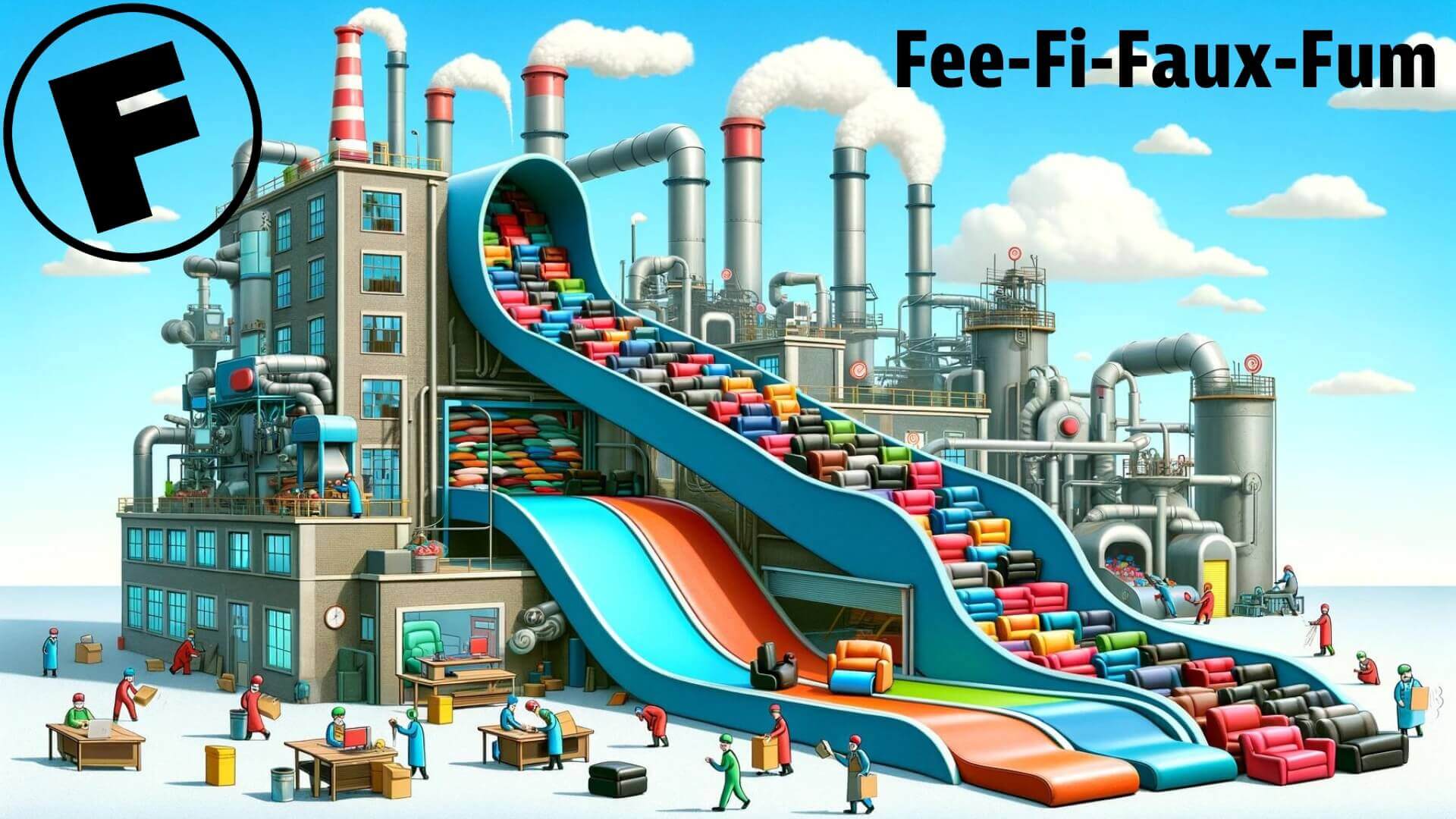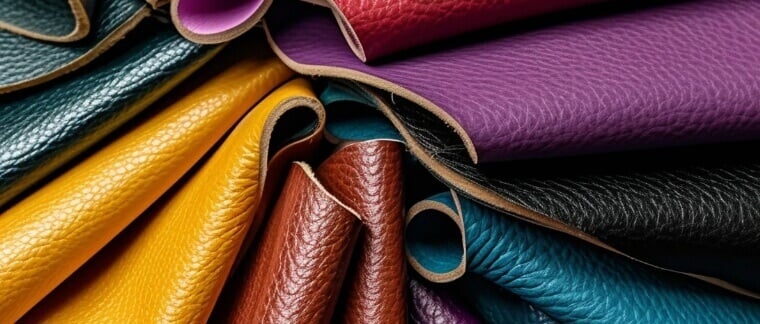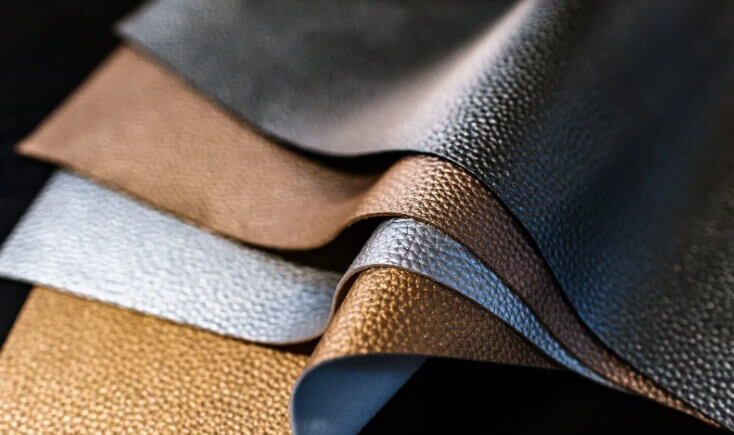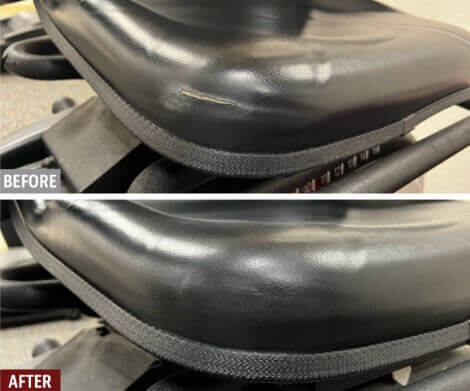What is Faux Leather?
Faux leather, aka synthetic leather, leatherette, vegan leather, pleather, artificial leather (the list goes on), is a material found everywhere nowadays. But the term “fake leather” has some negative connotations.
It has its advantages, though many argue it will never be able to replace the real deal. And it can also be hard to spot the difference.
With that, let’s dive into what faux leather actually is.

Faux leather history recap
Faux leather refers to materials that mimic the look and sometimes the feel of genuine leather but are manufactured from synthetic compounds. Its development is rooted in the early 20th century, driven by the need for more affordable and accessible materials to substitute for increasingly scarce and expensive genuine leather.
Over the years, technological advancements have dramatically improved the quality and texture of faux leather, making it a preferred choice in various industries.
Early beginnings
The inception of faux leather materials can be traced back to the invention of presstoff in the 19th century, a pressed and treated paper pulp used as a leather substitute. By the 1920s, the United States and Germany were experimenting with rubber and nitrocellulose to create coatings for cloth that resembled leather.
However, these early versions lacked durability and aesthetic appeal.
Modern materials
Today’s faux leathers primarily use polyurethane (PU) or polyvinyl chloride (PVC), two plastics that can be processed to take on a texture remarkably similar to real leather.
Innovations have also introduced materials like silicone leather, improving environmental performance and durability.
Types and production processes of faux leather
A couple of different types and different manufacturing processes are involved in creating synthetic leather.
Polyurethane (PU) leather
PU leather involves coating a base fabric such as polyester or cotton with a flexible polymer. This material can be further treated to create various textures and colors. PU leather is breathable, making it suitable for clothing and applications where comfort is paramount.

It’s also considered more environmentally friendly than PVC, as it does not create the same toxic byproducts during production—a significant class of environmental pollutants.
Polyvinyl chloride (PVC) leather
PVC leather is made by applying a layer of PVC to a fabric base and then adding plasticizers to make it more flexible. This type of faux leather is especially tough and water-resistant, making it ideal for outdoor use or products requiring a more rigid form.

However, the environmental impact of PVC, which releases harmful toxins during manufacture and disposal, has led to criticism and reduced its popularity in eco-conscious markets.
Manufacturing Techniques
The production of imitation leather involves several steps, tailored to the type of synthetic leather being produced. PU and PVC leathers begin by applying their respective plastics to a fabric-based material.
The material is then embossed to give it a grain similar to real leather goods. Various dyes and pigments can be used during the coating process to achieve coloration, allowing for a wide array of colors and finishes that natural leather cannot always offer.
Advantages of faux leather
There are some benefits to the use of PU and PVC leather products.
Economic and ethical benefits
Faux leather provides significant cost benefits over real leather, which requires extensive processing and labor from animal hide to finished product.
Additionally, it addresses ethical concerns associated with animal welfare and the leather industry’s environmental impact, appealing to vegan and environmentally conscious consumers.
Versatility in design
Unlike natural leather, synthetic alternatives can be produced in various colors and textures that do not rely on the natural variations of animal hides.
This consistency ensures that designers can work with a uniform material, which is particularly advantageous in mass-production settings.
Ease of repair
Although imitation leather is less durable than real high-quality leather, it has the merit of being easy to restore.

Faux leather products are low-maintenance but will inevitably suffer from scuffs, scratches, holes, etc. In that case, it’s super simple and cheap to repair the faux material yourself or hire a Fibrenew pro to do the job perfectly. This saves you money and keeps products out of landfills—something we are all about.
Disadvantages of faux leather
But there are inevitable drawbacks to faux leather fabric, too.
Environmental and durability concerns
Despite its benefits, faux leather has its drawbacks. PVC-based faux leathers contribute to environmental pollution by releasing phthalates and other hazardous compounds.
While PU is less harmful, it still involves petrochemicals in its production. Moreover, synthetic leathers typically have a shorter lifespan than genuine leather, susceptible to peeling and cracking.
Market perception
Although the quality of faux leather has improved, it still faces perception issues. Some consumers consider synthetic materials inferior to genuine leather in prestige and luxury.
Applications across industries
With its versatility and affordability, Faux leather finds application across various industries and products.
Here’s a breakdown of its common uses:
- Fashion and Apparel:
- Clothing: Faux leather is used to make jackets, pants, skirts, and vests, offering a stylish alternative to real leather.
- Footwear: Many shoes, including boots, sandals, and sneakers, are made with faux leather uppers.
- Accessories: Handbags, wallets, belts, and gloves often feature faux leather as a cruelty-free option for fashion accessories.
- Furniture:
- Upholstery: Sofas, chairs, ottomans, and headboards frequently incorporate faux leather upholstery for a sleek and modern look.
- Decor: Faux leather is also used in home decor items such as cushions, throw pillows and table runners.
- Automotive Industry:
- Car Interiors: Faux leather is commonly used for car seats, steering wheel covers, and interior trim, offering a cost-effective and easy-to-clean alternative to genuine leather.
- Interior Design:
- Wall Coverings: Faux leather wall panels add texture and sophistication to interior spaces, commonly used in offices, hotels, and upscale residences.
- Decorative Accents: Faux leather is used in lampshades, room dividers, and decorative upholstery for a touch of luxury.
- Electronics and Accessories:
- Cases and Covers: Tablets, laptops, and smartphones often come with faux leather cases and covers, providing protection and style.
- Tech Accessories: Faux leather mouse pads, cable organizers, and headphone cases are popular with tech enthusiasts.
- Sporting Goods:
- Sporting Equipment: Faux leather produces boxing gloves, baseball gloves, and weightlifting belts for its durability and water-resistant properties.
- Gym Equipment: Exercise mats, yoga blocks, and bags may also feature faux leather components for easy cleaning and maintenance.
- Marine and Outdoor Applications:
- Boat Upholstery: Faux leather is used for boat seating and cushions, offering resistance to water and UV rays.
- Outdoor Furniture: Patio chairs, loungers, and umbrellas may incorporate faux leather for outdoor durability.
- Medical and Healthcare:
- Examination Tables: Faux leather covers are used for medical examination tables because they are easy to clean and disinfect.
- Therapy Equipment: Treatment tables, massage chairs, and therapy mats may feature faux leather covers for hygiene and comfort.
These are just a few examples of how faux leather is utilized across various industries and products. It offers a cruelty-free, cost-effective, and versatile alternative to genuine leather.
Future Trends and Innovations
The future of faux leather looks promising with ongoing research into more sustainable and higher-quality alternatives.
Innovations, like bio-based faux leathers and recycling technologies, aim to reduce environmental impact and improve the performance of synthetic leathers.
Fibrenew is the leader in faux leather restoration
Faux leather continues to evolve, offering a viable alternative to traditional leather through materials science and manufacturing advancements.
Its role in various industries highlights the balance between innovation, ethics, and consumer demands. It points towards a future where faux leather can match or surpass genuine leather in performance and sustainability.
Get in touch with your local Fibrenew professional for all your leather, plastic, and vinyl repair needs.
Want to run a business that gives you incredible earning potential and the flexibility to take control of your time and life? Join the Fibrenew Family!
Check out our free Franchise Information Report for everything you need to know.
Also, enjoy these valuable resources on all things leather, plastic, and vinyl repair, franchising, sustainability, and more:
Stay tuned!
What is faux leather? Faux leather, also known as synthetic or artificial leather, is a man-made material designed to mimic the look and feel of genuine leather. It’s typically made from various plastic materials such as polyurethane (PU) or polyvinyl chloride (PVC). How does faux leather compare to real leather? Faux leather can closely resemble real leather in appearance and texture, but there are differences. Real leather tends to be more durable and ages with a natural patina over time. Faux leather may not have the same longevity, but it’s often more affordable, easier to clean, and can be produced without animal products. Is faux leather environmentally friendly? Faux leather can be considered more environmentally friendly than real leather in some aspects. It doesn’t require animal hides, reducing the environmental impact associated with livestock farming. However, the production of faux leather still involves using chemicals and petroleum-based materials, which can have their own environmental consequences. How do I care for faux leather? Caring for faux leather is generally easier than caring for real leather. Using a soft cloth, you can usually clean it with a mild soap and water solution. Avoid harsh chemicals or abrasives, as they can damage the material. Depending on the manufacturer’s instructions, you may also be able to use specialized faux leather cleaners. Is faux leather vegan? Yes, faux leather is typically vegan, containing no animal-derived materials. It’s a popular choice for those who prefer cruelty-free products. Is faux leather breathable? Because faux leather is made from synthetic materials, it is generally less breathable than genuine leather. It may not provide the same comfort level in hot or humid conditions. Does faux leather peel or crack? Faux leather can be prone to peeling or cracking over time, especially if it’s of lower quality or exposed to excessive wear and tear. However, higher-quality faux leather products are often engineered to resist peeling and cracking for longer periods. Can faux leather be recycled? Some types of faux leather can be recycled, depending on the specific materials used in its production. Polyurethane-based faux leather, for example, can sometimes be recycled. However, recycling options may be limited compared to natural materials like genuine leather. Is faux leather suitable for all uses? Faux leather is versatile and can be used for various applications, including clothing, furniture upholstery, accessories, and automotive interiors. However, it may not be as durable or breathable as genuine leather, so its suitability depends on the specific requirements of each use case. How can I tell if a product is made from faux leather?Faux leather FAQ


